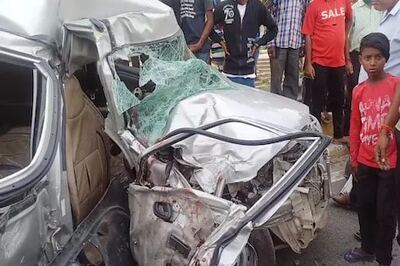
views
The victory of the National Democratic Alliance (NDA) in Bihar assembly elections is indicative that the fear of return of ‘jungle raj’ had an all-pervasive impact on the people and that ‘good governance’ was primary concern of the people rather than unemployment.
In the closely contested elections, the NDA led by Nitish Kumar won 125 seats while the Mahagathbandhan won 110, catapulting Janata Dal (United) president Nitish Kumar to a fourth term in office.
The opposition Mahagathbandhan, led by RJD leader Tejashwi Prasad Yadav, ran a campaign with several allurements like providing 10 lakh jobs at the first cabinet meeting but he could not influence the people, especially the youth. And caste-based politics played a role to certain extent as the Extremely Backward Castes (EBCs) and Mahadalits (Scheduled Castes) threw their weight behind the NDA candidates.
After the first round of polls on October 28, Prime Minister Narendra Modi took centrestage and made a scathing attack on the Rashtriya Janata Dal (RJD) governments led by Lalu Prasad and Rabri Devi between 1990 and 2005, a period often recalled by RJD rivals as ‘jungle raj’.
When it was realized that an anti-incumbency wave against Nitish Kumar might damage the poll prospects of the NDA, the Prime Minister made ‘jungle raj’ an election issue at poll rallies to remind people of the dark days. It seems to have worked and salvaged the NDA in the polls.
The 2020 poll verdict also comes as an endorsement of the NDA government and people’s faith in the leadership of Chief Minister Nitish Kumar and Deputy Chief Minister Sushil Kumar Modi for running a successful government with maturity and perceived integrity.
It has undeniably brought cheer to the JD-U, which was being written off by the pollsters. The verdict also reflects that Extremely Backward Castes (EBCs), that constitute little over 30 per cent of the total electorate, solidly stood behind NDA, especially Nitish Kumar.
Though the poll outcome has come as a major setback for the RJD in Bihar, it has catapulted Tejashwi to the spotlight as the emerging young politician of Bihar. Stepping out of his parents Lalu Prasad and Rabri Devi’s shadows, Tejashwi handled the campaign single-handedly and created an image which was acceptable among the upper caste youths to some extent. He has also improved his sagging image following RJD’s drubbing in the 2019 Lok Sabha polls.
The Muslims voted against the NDA and stood behind RJD-Congress combine. But their opposition to the NDA had an adverse impact on the Hindu votes which eventually united in favour of the NDA candidates. Even though the voting behaviour of Muslims remained largely un-fractured in favour of the RJD in 1990, 1995 and 2000 assembly elections, the Muslim representation has been lesser than those in 1985 and February 2005.
The results have brought little cheer to political outfits like Rashtriya Lok Samata Party (RLSP), Hindustani Awam Morcha (HAM) and Vikassheel Insaan Party (VIP) as they could not perform in the seats they had contested.
If caste preferences of voters are taken into account, it appears that while the Muslims and Yadavs – the core vote bank of the RJD – have strongly rallied behind the Grand Alliance candidates, the upper castes, especially the Brahmins and Bhumihars, split and supported the Congress candidates of their respective castes.
The LJP may have won just one seat but it has eroded the vote bank of the JD(U) in nearly 130 constituencies thereby indirectly helping the Mahagathbandhan candidates. It damaged the core vote bank of the BJP comprising the upper castes and Vaishyas. This bloc has only 18 percent votes but their influence gets amplified as they play an influential role in creating public opinion in the society and impacting the voting preferences of the intermediary castes.
The RLSP, led by former union minister Upendra Kushwaha, dented the NDA, especially the BJP, to an extent by garnering an average of over 5,000 votes of Koeris (Kushwahas) in many constituencies.
The BJP had fielded more than 51 candidates from the upper castes out of the 110 seats it contested. The remaining 59 seats were given to candidates belonging to Scheduled Castes and Extremely Backward Castes (EBCs). In 2015 assembly elections, the BJP had fielded 65 upper castes candidates, including 30 Rajputs, 18 Bhumihars, 14 Brahmins and three Baniyas.
The BJP-JD(U) combine has fielded 29 Rajputs, 25 Bhumihars, 13 Brahmins and 33 Yadav candidates in this election. Out of the 115 seats, the JD(U) has given tickets to 19 upper castes and 18 Yadavs. However, the experiment did not bear the desired fruit and Yadavs voted almost entirely in favour of the RJD.
If Nitish Kumar can claim to have somewhat arrested crime rate and seemingly set an agenda for development, his opposition, including RJD and the Congress, cannot claim as much. The political doles, aplenty, have been made possible by a proactive Nitish administration and a largely reactive RJD and Congress which did not pay attention to the development mantra.
However, the fact underwritten firmly in this election has been that Bihar has gained roundly from their cat-fight than it had ever since 1990.
(The author is a senior journalist. Views are personal.)
Read all the Latest News, Breaking News and Coronavirus News here




















Comments
0 comment